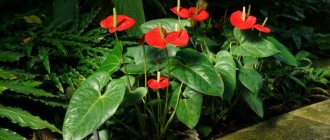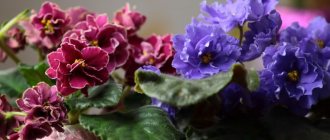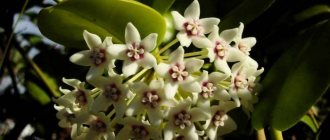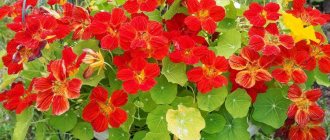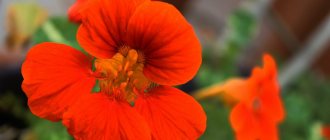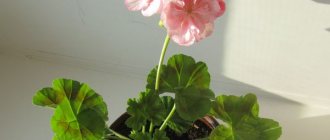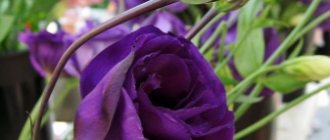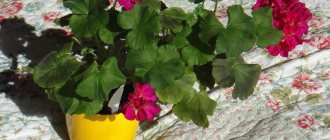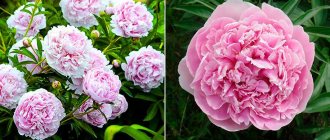Among the huge family of asteraceae, perennial asters stand out. And among them are low-growing and border varieties. The low-growing, or dwarf, aster is especially good for decorating borders, for planting along the edges of flower beds, large boxes, in landscape compositions in combination with evergreen shrubs, ornamental grasses or coniferous plants. Gardeners value low-growing asters for their frost resistance. It’s so nice to see the bright stars of dwarf asters in a garden that has fallen asleep on the eve of winter.
In total, there are about five hundred varieties of low-growing asters. Due to their non-ostentatious, in contrast to hybrid varieties grown for cutting, decorativeness and hardiness, low-growing asters are also called true asters.
This herbaceous plant is good for cutting and in open ground. Perennial asters have tough, erect stems densely covered with leaves ranging in height from twenty-five centimeters to one and a half meters. The leaves are small, rich dark green. Flowers, simple or double, with a diameter of one to five centimeters. The color palette of dwarf asters ranges from white and blue to purple and crimson. According to the time of development, they belong to several groups:
- early - bloom in May-June;
- summer - bloom in July-August;
- autumn - they bloom in September-November and even under the first snow they delight with bright heads of inflorescences.
Pictured are perennial asters
Description of varieties of perennial asters
There are about 500 species of perennial asters, and even more varieties of flowering crops have been bred from them. They differ in the height of the bushes, flowering time, the size and shape of the inflorescences and the color of the petals.
Alpine
This is a dwarf variety with a compact rosette and single buds with a diameter of 3-6 cm. The height of the plant does not exceed 30 cm. It looks impressive, but needs frequent updating.
It blooms in early summer and the buds stay on the bushes for about a month. The best varieties: snow-white Stained Glass, blue Gloria, light purple Goliath.
Italian
The variety, also called chamomile, can reach a height of 30 to 60 cm. Depending on the variety, it blooms in summer or early autumn.
Its inflorescences reach up to 5 cm in diameter. The petals are painted in lilac, pink, and dark blue tones. The best varieties: Gnome, Herman Lene, Kobola, King George.
New England (American)
This is a tall plant, the height of which can reach more than 160 cm, and about 80 cm in diameter. It has strong, strong, erect shoots that do not need support or garter.
The crop blooms in September, and the last buds leave after the onset of frost. The best varieties: Bars Pink with carmine pink petals, deep purple Constance, and Gloire de Kronstadt with large purple inflorescences.
New Belgian (Virginian)
This is a medium-sized variety, the height of which reaches 60-140 cm. The plant develops quickly and blooms in the first year after planting, around the beginning of September.
The shoots of the crop are not very stable and need to be tied to a support. The following varieties are in demand: red Royal Ruby, lavender Bridgette and White Lady with snow-white petals.
Bessarabian
The variety reaches up to 75 cm in height. It is valued for its abundant and long-lasting flowering.
It is distinguished by unusual buds, which consist of a brown core and purple petals.
Bush
These are low-growing flowers, the height of which does not exceed 50 cm. The buds open in mid-late August and last for about 1-1.5 months.
The best varieties are considered:
- raspberry red Jenny;
- dark red Stralight;
- snow-white aster Apollo;
- blue Blue Lagoon.
The most frost-resistant and unpretentious variety that can be grown in the northern regions.
Agerate-shaped
The plant reaches up to 150 cm in height. Its inflorescences resemble daisies in appearance, collected in corymbs. They stay on bushes from mid-August to the end of October.
The petals are painted in lilac or snow-white tones. The variety is ideal for meadow-type flower beds.
Globular
The variety is distinguished by an unusual crown, which takes the shape of a regular ball. The plant reaches up to 50 cm in height, and is densely covered with medium-sized inflorescences. The petals are colored blue, pink and purple with a yellow center.
The best varieties are recognized:
- Henry.
- Magic.
- Aspatio.
- Marmara.
Terry
This variety is distinguished by large, multi-petaled inflorescences that resemble bright balls.
The size of the plant depends on the subspecies. The best varieties: Bon-Bon, Erfurt dwarf.
Heather
The plant is distinguished by the pyramidal shape of the bushes and shoots sloping towards the ground. In September, the branches are densely covered with small pink or snow-white inflorescences. The shoots reach up to 100 cm in length, and they quickly grow in different directions. And the culture covers vast areas in a short time, creating a dense, floral carpet.
Popular varieties:
- Pink cloud.
- Snow avalanche.
- Blue Star.
Tatar
The aster species is a medicinal plant and grows up to 1.5 m in height. It has small, blue or pink inflorescences with a bright yellow core.
The only variety that thrives in the shade and in areas with moist soil. Can be planted on the banks of an artificial or natural reservoir.
The best varieties of these flowers
Flower growers have classified only two varieties as the best varieties of asters, and now we will talk about each of them in turn:
Chinese aster
A mixture of cut varieties of annual or biennial plants. They reach a height of 9-15 cm, it depends on the plant variety. It is worth noting that botanically they belong to different plant families. The bush blooms profusely, the flowers are double and of medium size.
Aster variety Novobelgian
An autumn plant variety that reaches a height of about 150 cm. Flowering begins in the last ten days of August and lasts until mid-November. In order for this variety of aster to grow well, it needs to be fed regularly.
Plant conditions
Perennial asters (the varieties whose photos are given in the material are considered the best) are unpretentious plants. But in order to achieve long and abundant flowering from crops, you will need to create a comfortable environment for them. To do this, you should plant flowers on soil with a certain composition, and provide them with proper care.
Lighting
Asters are light-loving flowers, and they should be planted in the most illuminated places. The plant will take root in light partial shade. But their flowering will come later and will be shorter.
Temperature
Perennial asters (varieties, photos and their descriptions are presented later in the article) are heat-loving plants. And they develop well at temperatures of +15...+30 °C. Flowers can also tolerate stronger heat, but only if they are watered regularly.
The article contains photos of popular varieties of perennial asters.
The crops are frost-resistant and overwinter in open ground, but it is worth preparing them for the cold period. To do this, choosing a dry and sunny day in October-November (after the onset of frost), you should cut off the above-ground part of the plant, leaving stumps up to 4 cm high.
Then sprinkle the bush with a 5-centimeter layer of sawdust, compost or fallen leaves. Mulch will prevent plants from freezing and provide them with useful elements in the spring. Young seedlings should be additionally covered with spruce branches.
Humidity
Aster develops better in conditions of high humidity. And in dry and hot weather it is worth regularly watering using the sprinkling method.
Soil and drainage
Despite their moisture-loving nature, perennial asters cannot tolerate stagnant moisture at the roots. They cannot be grown in lowlands, wetlands or places with close groundwater. It is better to plant the plants on a hill or arrange drainage in the flower garden in advance.
Perennial asters develop better in loose, fertile soil. Breathable loam with a neutral or slightly alkaline reaction is ideal for them.
It is worth preparing the area for the flowerbed in advance, following these instructions:
- Dig up the soil to a depth of 20-25 cm. Remove all plant debris and weeds.
- Add to each sq. m of soil 10 g of superphosphate, 8 g of potassium chloride. From organic matter, you can use compost (5 kg) and wood ash (200 g).
- If the soil is acidic, then add dolomite flour or fluff lime (400 g per 1 sq. m) into it.
- If there was no time for autumn preparation, then you can apply fertilizers in the spring. Otherwise, in April it is enough to simply dig up the soil to a depth of 18-20 cm.
Plants can be planted on the site no earlier than a month after applying fertilizers.
Watering
Asters are drought-resistant plants, but in hot weather they need to be watered regularly. With insufficient irrigation, the number of inflorescences is significantly reduced. And if there is no rain, then you will need to water the crops once every 10 days.
The next day after irrigation or precipitation, the soil must be loosened. Otherwise, a dense crust will form on its surface, blocking the access of air to the roots. During the loosening process, it is worth removing weeds that can be sources of diseases and pests.
To reduce the care of asters, you need to mulch the surface of the flower garden with organic matter. This technique will help reduce the amount of watering, loosening and weeding. But mulch tends to be washed out by water, so its layer needs to be renewed periodically.
Planting and caring for shrub aster in open ground
A representative of the Asteraceae family responds positively to care, but caring for the plant is no more difficult than caring for a chrysanthemum, together with which the perennial aster dilutes with bright colors the gloomy cold days of late autumn, when the low sun rarely comes out from behind the clouds to warm the earth with its rays.
When to plant bush asters
A place for an ornamental plant is chosen in an area with good lighting and protected from the wind; in the shade, the perennial does not bloom abundantly and suffers from fungal diseases. In mid-latitudes, shrub aster is sent to open soil in early April or at the end of March. In the northern regions, work on the ground does not begin until mid-May, until the soil has completely thawed after winter frosts, and bush asters, which bloom in August, are chosen for growing.
The area for the flowering perennial is dug up in the fall, diluted with sand to make the soil looser, fertilized with humus or prepared compost, and leveled with a rake.
In the spring, for planting, asters dig holes much larger than the root of the flower:
- Soil mixed with peat and sand is poured onto the bottom.
- The bush is lowered into the hole, deepening the neck 3 cm below the surface.
- Cover with the remaining soil, compact and irrigate.
In the first month and during the appearance of buds, the perennial is watered abundantly, but the soil is not allowed to become waterlogged. Feed the autumn aster a year after planting, apply a solution prepared from a 30 g bucket of water, superphosphate, 10-potassium salt, 20-ammonium sulfate under the bush.
Seedlings are watered with mineral mixtures when buds appear, during the flowering period, but nitrogen fertilizers, which enhance leaf growth, are avoided.
Sowing perennial aster seeds for seedlings
In the northern regions, herbaceous shrubs do not always have time to bloom before the onset of frost; to speed up flowering, summer residents first breed seedlings.
Growing conditions
The autumn shrub aster is moved into the yard, into a flowerbed or alpine hill at the age of one and a half months; therefore, sowing for seedlings begins after March 15 and ends in early April.
A disinfected wooden box or plastic container at least 10 cm high is filled with substrate.
How to plant correctly
The soil is sprayed with settled water, the disinfected and germinated bush aster seeds are laid out in rows, which is done every 3 or 5 cm. Using tweezers, the seeds are buried 5–10 mm, sprinkled with humus, but not planted densely. A wooden box or container is wrapped in plastic wrap and left in a well-lit place, where the temperature is maintained at 18–22°.
Aftercare
When the bush aster seeds sprout, which takes at least 5 days, the containers with the seedlings are opened, irrigated, freed from the film and placed on a well-ventilated, light windowsill. To maintain moisture in the substrate, bush aster seedlings are regularly watered, and to prevent mold from forming, they are ventilated every day. When the seeds germinate, which takes no more than a week, the shelter is removed.
Temperature
In order for the seedlings of a perennial flower to grow and not stretch out, heat in the room is not required. After the emergence of seedlings during the day, the temperature in the room is maintained at 20°C, and at night it is reduced to 15 or 17.
Lighting
Since bush aster seeds are sown for seedlings in early spring, when the day length is short, even when growing a herbaceous perennial in a south-facing window, phytolamps are additionally installed for illumination for 12 hours a day.
Watering
Irrigate bush aster seedlings using a spray bottle or syringe with settled warm water when the top layer of the substrate dries out.
Humidity
Before planting the seeds of a herbaceous perennial, holes must be made in the boxes, and expanded clay and small stones are poured into the bottom of the container to prevent stagnation of water, which leads to the death of the seedlings. The shrub aster does not have any special requirements for air humidity.
Priming
You can buy a substrate for growing autumn perennial seedlings at a gardening store or make it yourself by mixing 2 parts of peat, sand and 1 hour of soil. A perennial flower needs light and fertile soil.
Feeding
When 4 leaves appear, the seedlings are transplanted into separate peas, which are left in the apartment until the end of May. Before moving to a summer cottage or to a flowerbed under a window, which begins at the end of May, bush aster seedlings are hardened in the air, starting from 30 minutes, and then the boxes are left on an open balcony or in the yard for the whole day.
When 10 days have passed after picking, the seedlings are watered with ammonium nitrate, 1 kg of which is dissolved in 4 glasses of water. After 2 weeks, the same fertilizer is used for feeding in the same concentration, but 3 grams of superphosphate and 1.5 grams of potassium salt are added.
Hardened bush aster seedlings 7 cm high with 5 permanent leaves are transplanted into an open area, placing them at intervals of 30 cm between miniature varieties, 0.8 m is left between tall varieties.
When the flowers take root in the new place, which will take up to 2 weeks, they begin to fertilize with a mineral mixture; complex products are applied again when buds form, but they do not use nitrogen fertilizers.
Pruning bush aster
The decorative perennial keeps its shape and does not need pruning. To preserve decorativeness, broken, dry or crooked stems are regularly removed. To extend the flowering period in the fall, the fading corollas of the bush aster are cut off. For the winter, the branches are shortened at the root, leaving only 5 or 7 cm above the ground; pruning helps the perennial survive frosts and stimulates the active growth of stems with the onset of the warm period of the year.
Preparing bush aster for winter
An elegant flower, whose bright colors relieve the blues in the dull autumn season and give a positive mood, does not freeze at -30°, but when growing shrub aster in northern latitudes, the root zone is insulated with a layer of at least 10 cm, consisting of:
- from spruce branches;
- dry leaves,
- peat;
- sawdust
For wintering annual seedlings, agrofibre and spunbond are additionally used. To prevent the roots of the bush aster from rotting, the cover is removed until the end of March.
Diseases and pests
The perennial flower does not suffer from viruses and is rarely attacked by parasites, but needs protection from fungi. Sometimes, already during the period of the appearance of buds, summer residents notice that brown stripes form on the stems of the bush aster and the leaves begin to dry, which indicates the development of fusarium. To prevent the occurrence of a dangerous disease, in which it is necessary to destroy the affected flowers, the seeds are kept in a 2% solution of the drug Fundazol, and the planted bushes are sprayed with copper oxychloride.
With excessive watering and damp weather, perennial aster is affected by powdery mildew. The leaves become covered with a whitish coating, the flower stops growing.
Fungal spores that remain in the ground do not freeze out in winter and are carried by the wind, falling on asters and causing rust, which makes itself felt by the appearance of brown spots and growths on the leaves.
Bushes affected by fungal spores are destroyed because the flowers cannot be revived. To prevent the spread of infection to other asters, the branches are sprayed with copper sulfate or treated with Fundazol at least 4 times at weekly intervals.
The perennial suffers from an invasion of microscopic aphids, which not only draw sap from the leaves, but also spread viruses and fungal spores. The meadow bug, which loves heat and drought, does not refuse to feast on the flowers and buds of the bush aster. They cope with parasites by spraying the plantings with insecticides. With a small number of pests, treating the leaves and stems with a soap solution gives an effect.
How to collect aster seeds
With the end of flowering, small grains ripen in the drying corollas of the perennial, which are used for sowing. The fact that it is time to prepare planting material is indicated by dry petals, darkened and downy centers. In clear weather, large dried aster corollas are shaken, and the fallen seeds are collected, and before storage, spread out on cardboard or cloth, dried in the shade. The finished seed is poured into paper bags, signed and kept in a room where the humidity is not higher than 50–55°.
In regions where frosts begin early in the fall or there are prolonged rains, the seeds of late asters do not ripen. To speed up ripening, summer residents and flower growers cut off the heads, which they dry at home, laying them out on the windowsill. To prolong flowering and obtain high-quality seed, the bushes are dug up and transplanted into a room with good lighting; to ensure even exposure to sunlight, the container with the flower is periodically rotated along its axis.
Step-by-step instructions for growing
Perennial asters (varieties, photos, characteristics are described in the article for reference) are usually grown from seeds. And they can be planted immediately in open ground (in a training bed). The event should be started in mid-spring, when the ground has warmed up sufficiently and the air temperature does not drop below +10 °C.
And in the process you need to adhere to the following algorithm:
- Level the surface of the soil and make grooves in it with a depth of 4 cm. Maintain a distance of 15-30 cm between rows, depending on the growth of the plants.
- Water the bed generously with warm water. Distribute the seeds evenly along the grooves and sprinkle them with soil. The embedment depth should not exceed 0.5 cm.
- Mulch the surface of the flower bed with peat, straw or sawdust.
- If there is a risk of return frosts, then it is worth covering the flower garden with lutrasil or film.
At temperatures above +20 °C, seedlings appear within 10-12 days. In the future, the plants need to be provided with regular care, and in the fall they need to be transplanted to a permanent place. Such crops will bloom only after 1-2 years.
Wintering
Perennial medium- and tall-growing asters are pruned before wintering, leaving stems up to 5 cm high above the ground. In areas with cold winters, add a layer of fallen leaves or other mulch to the bushes. In the spring, this insulation must be removed with the onset of the first stable positive temperatures. Low-growing bushes are not pruned for the winter.
The snow lingering in the dried stems of the plant serves as insulation for these bushes. For preventive purposes, before going into winter, the bushes are sprayed with a solution of 50 g of copper sulfate in 10 liters of water.
Plant propagation methods, instructions
Perennial asters, photos of which are given in the material, can be propagated by dividing the bush and by green cuttings. These methods are suitable for all varieties and types of plants, but they have their own nuances.
Dividing the bush
This propagation method is suitable for adult plants. And it can be combined with a planned transplant. But it is worth considering that varieties that bloom in autumn are best divided in spring. Conversely, varieties that produce buds in the summer should be propagated in the fall.
The process itself is not particularly complicated and consists of the following steps:
- For new plants, you need to prepare the site in advance and add fertilizer to the soil. Make holes with a depth of 20-25 cm. Depending on the growth of the plants, maintain a distance of 20-50 cm between them.
- Dig up the mother bush, carefully clean its roots from the old earthen lump. If necessary, prune damaged shoots and weak shoots.
- Using a shovel or knife, divide the plant into several parts. Each division should contain 3-5 shoots, 1-2 growth points and a sufficient number of roots. Sprinkle the cut areas with chiseled activated carbon or wood ash.
- Place the plants in the center of the recesses and slightly straighten their roots. Fill the voids with soil and compact it slightly. It is important that the growing points of the divisions are buried in the soil at the same level as those of the mother plant.
- Water the flower bed generously. When the moisture is absorbed, add soil if necessary.
- It is advisable to mulch the surface of the flower bed with a centimeter layer of peat, straw or rotted compost.
If the site has been properly prepared, then you will not need to feed the flowers for 1-2 years.
Propagation by cuttings
Perennial asters can be cut from May to August. And for propagation it is worth using the apical green shoots. Before the event, you should prepare a training bed by choosing a lighted area for it, but without direct sunlight.
You will also need to make a substrate by mixing peat with turf soil and sand in equal parts.
During the process you must adhere to the following instructions:
- Having chosen strong shoots up to 15 cm in length, cut them with a sharp knife. Moreover, the cut should be made at an angle of 45°. Remove the lower leaves, leaving only the green top.
- Place the cuttings in a growth stimulator (“Epin”, “Zircon”) for 10-12 hours, burying them in the liquid by 2-3 cm with the lower cut.
- Plant the shoots in a training bed at a slight slope and water well.
- It is advisable that the temperature near planting be maintained within +22…+25 °C. You can stretch the film over the ridge and open it slightly in hot weather.
- During the process, it is important to regularly spray the soil with warm water, preventing it from drying out. You should also remove condensation from the shelter, since excess moisture is detrimental to the plant.
By autumn, the cuttings will take root and can be planted in a permanent place. Before winter, plants should be prepared by sprinkling them with a thick layer of peat or fallen leaves and covering them with lutrasil or spunbond. With the arrival of spring, remove the cover and remove the mulch so that the flowers do not dry out.
Proper watering
Water the flowering bushes of perennial asters once a week at air temperatures above + 15°C. In cool weather, watering is stopped; in severe drought, the amount of watering is increased. Perennial asters can do without watering in hot weather, but then their stems will begin to thin, dry out, and flowering will be weak.
During severe droughts, plants without watering may die. The depth of water penetration into the soil should be small, because the roots of the bushes do not grow in depth, but to the sides. After heavy rains, loosening the soil is necessary.
When to plant petunia seedlings
Pest and disease control
Perennial asters (varieties, photos, features are described in the material for reference) have strong immunity and rarely get sick.
But in unfavorable conditions, crops can be affected by the following diseases and pests:
| Symptoms | Treatment | |
| Blackleg | A fungal disease that causes thinning and blackening of stems at the base. | At the first signs, you need to treat the soil with a solution of potassium permanganate or Fitosporin. Repeat treatments every 7 days until cured. |
| Fusarium | A fungal disease that occurs from excess soil moisture. The disease appears as dark stripes on the leaves and stems of the plant. Over time, the foliage turns yellow and the inflorescences wilt. | Regular lime helps fight fusarium. It needs to be scattered around the flower bed. |
| Septoria | The disease is provoked by waterlogging of the soil and high air temperature, and it can be recognized by dark brown spots on the foliage. | To get rid of septoria, you need to spray the flowers with a solution of Bordeaux mixture every 7 days until the symptoms disappear. |
| Jaundice | A viral disease transmitted by pests. The leaves turn yellow and the buds stop developing. | The disease cannot be treated, and affected specimens will need to be destroyed. |
| Aphid | Small brown or green pests that accumulate in the axils of leaves and feed on their sap. | To kill insects, you should use Aktara insecticides. |
| Spider mites | The pest is difficult to notice with the naked eye. But its appearance is indicated by a thin sticky web that accumulates in the axils of the leaves. | It is worth spraying the flower garden with an alcohol solution, infusion of garlic or onion. The insecticide "Karbofos" helps against a large colony. |
The flower garden should be treated with insecticides and fungicides early in the morning. And for the procedure you should choose a dry, windless day. Since the drugs are toxic, you need to wear gloves, long sleeves and a respirator before use.
Possible problems in growing
An attentive gardener immediately sees external changes in his favorite flower.
Problems with leaves
If the leaves begin to turn yellow, become brown, curl and dry out, this indicates improper care or the development of a disease.
First of all, you need to make sure that the flower is not overdried. You can try changing the soil moisture regime. If black longitudinal stripes are added to the listed factors, this indicates the development of fusarium. This disease appears if the soil is overly moistened and there is stagnation of water in the root system. In this case, it is impossible to save the plant.
The appearance of lumpy spots also indicates the development of late blight. To overcome the disease, it is necessary to cut off all affected areas and sprinkle with activated carbon.
Pests
Aphids, thrips and cicadas are the main pests of asters. They suck the sap from the plant and are carriers of diseases. To prevent the appearance and reproduction of insects, it is necessary to treat the flowers with Fitoverm solution or other insecticides.
The earwig is capable of gnawing not only the leaves of the flower, but also the stems and buds. To drive away the insect, it is necessary to regularly remove weeds and loosen the soil.
Important! When the first signs of spider mites are detected, it is recommended to treat the leaves and stems of the plant with a soap solution
Diseases
Mosaic disease appears as yellow streaks on the leaves. After this, chlorosis develops and the plant stops developing. To overcome this disease, it is recommended to treat the bush with Actelik or Peritrum.
Aster rust is a fungus whose natural habitat is the needles of pine trees. The disease is characterized by the appearance of swellings on the lower part of the leaves. They are filled with rusty spores. For treatment, use a 1% solution of Bordeaux liquid. Treatment is carried out after 10 days. If the disease is detected late, the bush is almost impossible to save.
Signs of improper care
Aster, although an unpretentious plant, will immediately tell its owner about improper care. First of all, the leaves of the plant signal this. They may wilt or change color. If measures are not taken on time, improper care will affect flowering. The inflorescences will be sparse and pale. In addition, the plant will have few flowers.
Aster
Many different types of asters have been bred. Before purchasing a particular variety, it is recommended that you read the description of the flower in more detail. General principles and rules may sometimes not be suitable for individual hybrids
If the flower bed is constantly updated, then it is recommended to pay attention to annual varieties
Fertilizers for plants
Perennial asters spend a lot of energy on flowering, and they need additional nutrition.
So it is advisable to fertilize crops at least 2-3 times per season, adhering to the following scheme:
- In mid-May, add complex mineral fertilizers rich in nitrogen to the flower garden. The element is necessary for the normal development of green mass.
- During budding, add fertilizer containing potassium and phosphorus.
- At the beginning of flowering, fertilize the plants with potassium compounds.
Any fertilizer can be applied only after abundant watering, so that the compounds do not burn the roots of the plants. It is better to choose a cloudy, cool day for the event. Or you will need to do it early in the morning.
Mineral mixtures
At the beginning of the growing season, you can feed asters with urea or saltpeter. During budding it is worth using ammophoska, nitrophoska, crystallin or superfsofat. When buds form, you need to add potassium chloride and potassium sulfate.
It should be remembered that excess fertilizer is harmful to flowers. And it is necessary to apply half the dose of fertilizing that is indicated by the manufacturer. It is advisable to dilute the preparations with water and use them in liquid form.
Organic fertilizers
Asters should not be fed with organic matter. And manure is especially contraindicated for plants. But you can use a solution of mullein or bird droppings. These fertilizers contain a lot of nitrogen and should only be applied at the beginning of the growing season. And they must be diluted in a ratio of 1 to 10.
It is also worth using compost or humus to mulch the flower bed; a layer of materials will nourish the plants as they decompose, and at the same time help retain moisture at the roots.
How to plant asters correctly, planting methods
A distinctive feature of perennial asters, in addition to frost resistance, is their strong branched root. It is these two features that give the plant the opportunity to grow in one place for 3-5 years. Most often, asters are propagated by dividing the root system into several shoots. This is the easiest way to get the plant to bloom the same year it is planted. A perennial aster grown from seedlings will bloom only for 2-3 years.
The soil for a new bush is prepared in the fall, dug up with a shovel and fertilizers are added. Asters are not demanding on soil fertility, but potassium-phosphorus fertilizers with a predominance of phosphorus will help them set many buds after transplantation. In the spring, after the first leaves appear on shoots 3-5 cm high, the young outer shoots are separated from the main bush and transplanted to a prepared place.
Perennial asters are planted along paths as fences, in flower beds to create spots of color, on rocky hills, and in flower beds. Low-growing varieties are used to decorate the banks of garden ponds. To create a two-color bush, two plants of the same species and varieties of different contrasting colors are planted in one hole. Low-growing asters look good against the backdrop of tall flowers.
Use in landscape design, examples
Perennial asters will be an excellent plant for the background of a flower garden. Tall varieties of the crop can be used to create hedges. Small plants should be used to decorate garden paths and borders. Also, dwarf varieties are suitable for growing in rock gardens, rock gardens, and in the foreground of flower beds.
It is better to plant perennial asters next to carnations, peonies, lilies and roses. But they are not suitable for proximity to garden crops (potatoes, tomatoes) and conifers, because of which the flowers begin to hurt.
True low growing aster
There are many different legends about asters, each with its own meaning. Do you know why these flowers are called true? No. Then we will tell you - there are plants that are planted to create bouquets, compositions, for cutting - for certain purposes. You can’t do something similar with low asters, well, perhaps, put them in a vase on the table. But this is why they are loved - a person does not see the benefits, but sees only true beauty.
Although this is debatable. There is still a benefit - if your flowerbed or garden path is not perfectly beautiful, you can always change the situation with the help of dwarf asters. They are truly great. Their versatility also lies in the fact that flowers can be planted not only in the garden, even without seedlings, but also in flowerpots, flowerpots, and pots. All this will decorate any veranda; such asters can grow even at home or on the balcony.
For information! Asters are a huge number of species, varieties, each of them is divided according to the shape of the flower, bush, height, and flowering time. But for the most part, the flowers are quite unpretentious and have similar agricultural technology.
Where to buy and cost of the plant
Seeds of perennial asters can be purchased in flower shops and special departments of supermarkets. When choosing planting material, it is important to pay attention to the expiration date. And you should not take seeds collected more than 1 year ago, as their germination rate is minimal. They must be dry and hermetically sealed.
The cost of seeds is low; on average, you need to pay 25-40 rubles for a package weighing 0.1 g. Ready-made seedlings are more expensive, and 1 copy will cost 300-500 rubles.
Perennial asters will be an excellent decoration for any site. Numerous varieties of crops look impressive and fit into any landscape, as confirmed by photo flower gardens. At the same time, the plant is unpretentious, frost-resistant, and caring for it will not cause much trouble.
Aftercare
The perennial low-growing aster does not require special care. This is an unpretentious plant, but for more luxuriant flowering you need to perform a number of measures. So, the weeds around it must be removed so that the pests do not choke out the small flowers. It’s better to mulch the soil with a mixture of peat, tree bark, or cover it with ordinary sawdust, then you can forget about weeds. Mulch will not only act as a weed killer, but will also allow the soil to remain moist for a long time.
Watering
Astra does not like excessive watering, especially when water lingers on the soil. But in order for flowers to grow faster, in summer, in hot or dry times, it cannot do without moisture. It is recommended to water in the evening.
Top dressing
Decorative varieties need organic matter, lime and mineral fertilizers for normal development. They are brought under the bushes in spring and summer. Humus promotes active growth, and fertilizing with phosphorus will help the plant form large inflorescences.
Trimming
The small shrub aster is pruned to at least 10 centimeters to form a beautiful crown. In this case, compact bushes look better in border options. The event is held in autumn or early spring.

